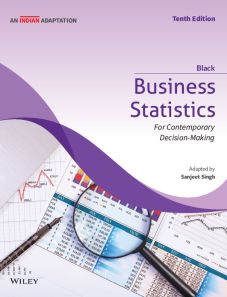Business Statistics 10ed: For Contemporary Decision Making (An Indian Adaptation)
ISBN: 9789354640179
For more information write to us at: acadmktg@wiley.com

Description
Business Statistics continues the tradition of presenting and explaining the wonders of business statistics through a clear, complete, student-friendly pedagogy. In this 10th edition, author Ken Black uses current real-world data to equip students with the business analytics techniques and quantitative decision-making skills required to make smart decisions in today’s workplace.
- Introduction to Statistics and Business Analytics
1.1 Basic Statistical Concepts
1.2 Data Measurement
1.3 Introduction to Business Analytics
2 Visualizing Data with Charts and Graphs
2.1 Frequency Distributions
2.2 Quantitative Data Graphs
2.3 Qualitative Data Graphs
2.4 Charts and Graphs for Two Variables
2.5 Visualizing Time-Series Data
3 Descriptive Statistics
3.1 Measures of Central Tendency
3.2 Percentiles and Quartiles
3.3 Measures of Variability
3.4 Measures of Shape
3.5 Business Analytics Using Descriptive Statistics
4 Probability
4.1 Introduction to Probability
4.2 Structure of Probability
4.3 Marginal, Union, Joint, and Conditional Probabilities
4.4 Addition Laws
4.5 Multiplication Laws
4.6 Conditional Probability
5 Discrete Probability Distributions
5.1 Random Variables
5.2 Discrete Random Variables
5.3 Describing a Discrete Distribution
5.4 Bernoulli Distribution
5.5 Binomial Distribution
5.6 Negative Binomial Distribution
5.7 Poisson Distribution
5.8 Geometric Distribution
5.9 Hypergeometric Distribution
6 Continuous Probability Distributions
6.1 Discrete versus Continuous Probability Distributions
6.2 The Uniform Distribution
6.3 Normal Distribution
6.4 Using the Normal Curve to Approximate Binomial Distribution Problems
6.5 Exponential Distribution
7 Sampling and Sampling Distributions
7.1 Sampling
7.2 Sampling Distribution of Sample Mean
7.3 Sampling Distribution of Sample Proportion
8 Statistical Inference: Estimation for Single Populations
8.1 Estimating the Population Mean Using the z Statistic (σ Known)
8.2 Estimating the Population Mean Using the t Statistic (σ Unknown)
8.3 Estimating the Population Proportion
8.4 Estimating the Population Variance
8.5 Estimating Sample Size
9 Statistical Inference: Hypothesis Testing for Single Populations
9.1 Introduction to Hypothesis Testing
9.2 Testing Hypotheses About a Population Mean Using the z Statistic (σ Known)
9.3 Testing Hypotheses About a Population Mean Using the t Statistic (σ Unknown)
9.4 Testing Hypotheses About a Proportion
9.5 Testing Hypotheses About a Variance
9.6 Solving for Type II Errors
10 Statistical Inferences About Two Populations
10.1 Hypothesis Testing and Confidence Intervals About the Difference in Two Means Using the z Statistic (Population Variances Known)
10.2 Hypothesis Testing and Confidence Intervals About the Difference in Two Means: Independent Samples and Population Variances Unknown
10.3 Statistical Inferences for Two Related Populations
10.4 Statistical Inferences About Two Population Proportions, p1 − p2
10.5 Testing Hypotheses About Two Population Variances
11 Analysis of Variance and Design of Experiments
11.1 Introduction to Design of Experiments
11.2 The Completely Randomized Design (One-Way ANOVA)
11.3 Multiple Comparison Tests
11.4 The Randomized Block Design
11.5 A Factorial Design (Two-Way ANOVA)
12 Simple Linear Regression and Correlation
12.1 Correlation
12.2 Introduction to Simple Linear Regression
12.3 Determining the Equation of the Regression Line
12.4 Residual Analysis
12.5 Standard Error of the Estimate
12.6 Coefficient of Determination
12.7 Hypothesis Tests for the Slope of the Regression Model and Testing the Overall Model
12.8 Estimation
12.9 Using Regression to Develop a Forecasting Trend Line
12.10 Interpreting the Output
13 Multiple Regression Analysis
13.1 The Multiple Regression Model
13.2 Significance Tests of the Regression Model and Its Coefficients
13.3 Residuals, Standard Error of the Estimate, and R2
13.4 Interpreting Multiple Regression Computer Output
14 Building Multiple Regression Models
14.1 Nonlinear Models: Mathematical Transformation
14.2 Indicator (Dummy) Variables
14.3 Model-Building: Search Procedures
14.4 Multicollinearity
14.5 Logistic Regression
15 Time-Series Forecasting and Index Numbers
15.1 Introduction to Forecasting
15.2 Smoothing Techniques
15.3 Trend Analysis
15.4 Seasonal Effects
15.5 Autocorrelation and Autoregression
15.6 Choosing an Appropriate Forecasting Model
15.7 Index Numbers
16 Analysis of Categorical Data
16.1 Chi-Square Goodness-of-Fit Test
16.2 Contingency Analysis: Chi-Square Test of Independence
17 Nonparametric Statistics
17.1 Runs Test
17.2 Mann-Whitney U Test
17.3 Wilcoxon Matched-Pairs Signed Rank Test
17.4 Kruskal-Wallis Test
17.5 Friedman Test
17.6 Spearman’s Rank Correlation
18 Statistical Quality Control
18.1 Introduction to Quality Control
18.2 Process Analysis
18.3 Control Charts
19 Bayesian Statistics and Decision Analysis
19.1 Revision of Probabilities: Bayes’ Theorem
19.2 An Overview of Decision Analysis
19.3 The Decision Table and Decision-making Under Certainty
19.4 Decision-making Under Uncertainty
19.5 Decision-making Under Risk
19.6 Utility
19.7 Revising Probabilities in Light of Sample Information
Appendix A Tables
Appendix B Answers to Selected Odd-Numbered Quantitative Problems
Glossary
Index

